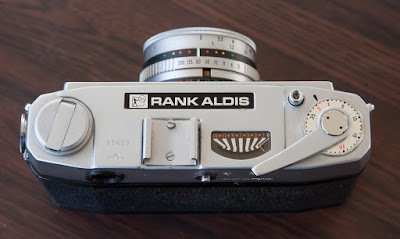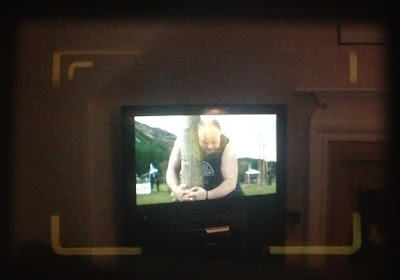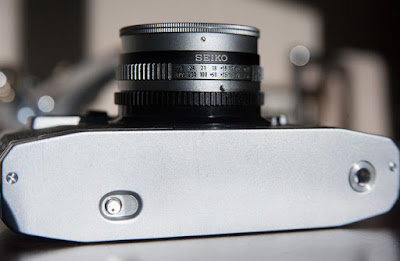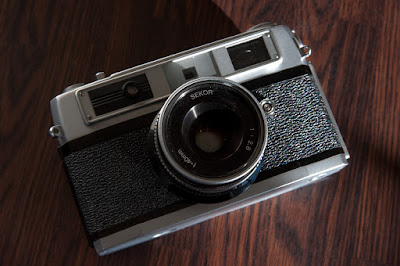Here's a camera that might be new to you. It's a Rank Aldis rangefinder and is an unplanned addition to my camera cupboard. There's a Barnardo's charity shop that we donate to and when I'm in I usually ask if they've any old film cameras kicking about. That's how I picked up the Voigtlander Vitessa a while back.
Last Saturday, I looked in just out of curiosity and the girl behind the counter remembered me. After we'd exchanged a few pleasantries she asked, "Are you still looking for old cameras?" "I always am," I replied. There's an M3 out there somewhere with my name on it but I didn't share that with her. She pointed to a shelf where there were a couple of Zenith SLRs and this wee rangefinder.
To be honest, I wasn't too keen. I didn't think it was interesting enough and I suspected it would end up sitting on a shelf. I looked it over and the spec was quite decent really - a coupled rangefinder, what appeared to be a non-functioning CDS meter and a 40mm f2.8 lens, probably a Tessar.
When I got back to the car I did a quick bit of research on the phone. I knew from memory that it was a Mamiya of some sort, rebranded for Rank, who were major UK Mamiya importers in the 1960s and 1970s, but which particular model I'd no idea. There is very little, it turns out, about Rank Aldis cameras on the web. Ironically, this page will probably be the best source now.
 |
| The top plate with its familiar and logical lay-out. |
Well, it's a Mamiya 4B, a slightly improved version actually with a better lens. There was a Mamiya model above this one called the Ruby so the Rank is in between it and the 4B. It's a child of the early 1960s - a bit like me really - so there's definitely a certain affinity there. So what's it like, I hear you all ask in unison. Actually, it's very nice indeed. I showed it to my 16-year-old, long-suffering daughter Freya who said something like, "Wow, a camera. What's special about this one then?" I said it only cost £7 and does much the same as the Leica, referring to it's rangefinder layout, obviously. "Then why did you pay so much for the Leica?" she asked. I beat a tactical retreat.
But the Rank (can there ever have been a worse name for a camera?) does, more or less, what the M2 does. It's not as robustly made, probably not as reliable although it's still working perfectly more than 50 years later from what I can tell and that's more than can be said for most unserviced Leicas, and doesn't take interchangeable lenses. But, in a direct comparison with the M2 and 50mm Summicron, it would be interesting to see how much of a difference there actually is.
 |
| The small button in the middle of the top plate switches on the meter. |
 |
| A smooth, ratcheted film advance lever and a frame counter that has to be manually reset. |
The viewfinder (below - poor iPhone pic) is perfectly usable. It's slightly cooler in tone than the Leica's and not as bright. The rangefinder patch on this one is visible if not too distinct (on the tosser's head) but the rangefinder focusing seems to work just fine and is easy enough in action. The field of view is delineated by yellow suspended frame lines with a parallax correction line in the top left corner.
I reckon the viewfinder will clean up quite well. I haven't done anything at all to the camera yet but I can see muck on the rear of the finder and inside it. Thankfully, there's a plate on the front that encompasses the rangefinder and viewfinder windows and the meter cell and it simply screws off so it should be possible to improve it quite a bit. It's amazing the difference a careful wipe with a cotton bud can make.
 |
| The viewfinder is much better than it appears here but this at least gives you an idea of the frame lines. |
 |
| This is a better effort. It's not a bad viewfinder at all really. |
 |
| An exposure meter calibrated in EV levels - not a bad design on a manual rangefinder. |
Unusually for a camera of this age and class, it sports not a selenium celled meter but a battery-operated CDS affair. It's marked in EV units. In the pic above, the small, chromed button just to the right of the accessory shoe is pressed to activate it. The needle in the meter window swings to the left and you then read off the EV level. That's then set on the lens (the little black window with "10" in it in the pic below) according to which aperture/shutter speed combination you desire.
It's a good system and quick in use. Once you've set the EV number, you can chop and change the aperture and shutter speed as long as you keep the EV number the same unless you want to over-ride it.
The aperture ring has no clicks stop buts those on the shutter speed dial are nice and positive. The range on the Seiko shutter is limited to just 1/4s to 1/250th plus B. OK, it's not huge but it's perfectly workable provided you load up with a film around the 100 ISO speed or carry a neutral density filter for a faster emulsion.
 |
| I've no problem adjusting the shutter speed dial or focusing but the aperture ring is quite close to the camera body making it difficult for someone with chunky fingers to operate it easily. |
The focus ring at the front of the lens is very smooth but a little on the heavy side. That's probably down to the fact that the grease used on the lens helical has lost some of its viscosity over the years. It's not a problem at all: it just requires a little extra effort to turn it.
The pic below shows the CDS window with the cell well shielded so it's not easily influenced by strong sidelight. I did a quick comparison reading against my Nikon D700 and the pair matched at lower light levels. The Rank reads two stops under at outdoor levels, though.
However, it seems the camera takes an S76 which is the same as the common SR44 - silver oxide as opposed to the alkaline LR44. The LR44 I used - same voltage as the SR44 but not as stable or long-lived - was quite old and it's possibly just lost some of its output. I'll try it with a new SR44 to see if that fixes it.
 |
| The battery cover has a slot for a coin to assist in unscrewing it but it's also very easy to just grab hold of the knurled edges - much more accessible than many an SLR. |
The lens front is very plain-looking. No snazzy graphics or design, no serial number, just the bare bones of model, focal length and maximum aperture. I don't know for sure but I'm guessing it's a four-element optic of the Tessar design. A 40mm f2.8 doesn't make too many demands of the design so it's likely quite sharp. However, the proof of the pudding is in the eating so I won't know for sure until I've taken a few pics with the camera.
The film speed is set by moving the small nubby dot beneath the lens (see below). It's range of 10 to 400 ASA (ISO) is all you need given the restricted shutter speeds. Tripod socket and film rewind release button are in their usual position on the underside.
Here are some comparison pics in Hollywood lighting to give you an idea of the size of the Rank. It's slightly taller than the M2 but not as long. Although the body of the camera is thicker than the M2's, once you add in the lens then the Leica is the wider of the two. It compares favourably in size to the OM2n being just a little taller and longer. Overall. though, there's really not much to choose at all between the sizes of all three. They'd displace about the same amount of water in a bath.
The shutter is quite quiet although I've heard quieter leaf shutters. The timed shutter speeds sound on the long side but, again, a test film will show what's what. The rangefinder seems accurate and is properly aligned. it seems to be possible to adjust it easily enough should it turn out to need any attention.
Otherwise, the only thing that's needs some work before loading a film are the light seals on the back. I knew as soon as I picked the camera up and felt the loose back that they were gone. Sure enough, they're on their way to goo status but it's an easy fix. But, since we have the house on the market, we've been boxing stuff up and my wee supply of light seals is packed away I know not where. Before using the camera, I'll give everything a good clean, especially the somewhat mucky lens which seems to be scratch and fungus free but is a trifle grubby. The viewfinder will also get a going over.
The more I played with this camera, the more I grew to enjoy it. I'd have preferred to have kept the Voigtlander Vitessa just for its 50mm f2 Ultron lens but its viewfinder was fairly unusable for me whereas the Rank isn't too bad at all in that department. The £7 I paid was not a great bargain as you can pick them up on Ebay for around that depending on condition. If the lens performs then I'd have to say it's a hell of a camera for that sort of money!
So that's the Rank Aldis, a wee gem of a camera that's well-specified, well-built, nicely thought out and, although I've yet to run a film through it, no doubt capable of the type of high quality results you might expect from a Mamiya product. Remind me again: why did I spend all that on a Leica?


















Neat little kit. Sometimes gem's are found in unusual places. It's is nice to see the camera can be operated all manual, with independent shutter speed and aperture. around the mid 70's so many small 35mm RF cameras started to be auto only, ugh, just cannot abide any camera that does not give me full manual control, at least as an option.
ReplyDeleteCurious to see some pictures!!!
ReplyDeleteThere's a ton of these wee rangefinders out there and they always irk my curiosity - hope it works well with no spacing problems - it looks like a nice little machine, and the Seiko shutters are really pretty damn good usually..
ReplyDeleteAs for the EV system - got it on the Rollei T and also the Hasselblad - I use it all the time - it's a very quick and easy way of setting aperture/speed combinations - beats me why more people didn't use it.
SR44 vs LR44 will make a difference even with brand new cells, if the camera wasn't designed with the LR type in mind. At least it did with my Olympus XA. With the right cells, it has proven to be crazy good accurate.
ReplyDeleteThanks for a great little article. I got one of these off eBay but with stuck shutter leaves so I'm going to attempt my first ever repair of this kind of thing. Your articles really helped given finding a manual for these things seems a lot header than normal for old cameras.
ReplyDeleteIn the interim I've ended up buying another since they're so cheap and that 60s styling is amazing! Here's to shooting with it!
I've had one of these for a couple of years now and it has preformed brilliantly so much so that when one turned up on E BYE-GUM BAY I bought it for my daughter. What I like about it is it feels solid and well built, also the use of the colour dots to aid in hyper-focusing. The lens gives sharp images with very little fall of at the edges. When out in the streets with it I'm often stopped and asked about it especially from other photographers, who again admire it's build quality.
ReplyDeleteAnother great article and thanks for publishing.